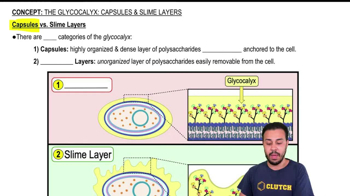Table of contents
- 1. Introduction to Biology2h 40m
- 2. Chemistry3h 40m
- 3. Water1h 26m
- 4. Biomolecules2h 23m
- 5. Cell Components2h 26m
- 6. The Membrane2h 31m
- 7. Energy and Metabolism2h 0m
- 8. Respiration2h 40m
- 9. Photosynthesis2h 49m
- 10. Cell Signaling59m
- 11. Cell Division2h 47m
- 12. Meiosis2h 0m
- 13. Mendelian Genetics4h 41m
- Introduction to Mendel's Experiments7m
- Genotype vs. Phenotype17m
- Punnett Squares13m
- Mendel's Experiments26m
- Mendel's Laws18m
- Monohybrid Crosses16m
- Test Crosses14m
- Dihybrid Crosses20m
- Punnett Square Probability26m
- Incomplete Dominance vs. Codominance20m
- Epistasis7m
- Non-Mendelian Genetics12m
- Pedigrees6m
- Autosomal Inheritance21m
- Sex-Linked Inheritance43m
- X-Inactivation9m
- 14. DNA Synthesis2h 27m
- 15. Gene Expression3h 20m
- 16. Regulation of Expression3h 31m
- Introduction to Regulation of Gene Expression13m
- Prokaryotic Gene Regulation via Operons27m
- The Lac Operon21m
- Glucose's Impact on Lac Operon25m
- The Trp Operon20m
- Review of the Lac Operon & Trp Operon11m
- Introduction to Eukaryotic Gene Regulation9m
- Eukaryotic Chromatin Modifications16m
- Eukaryotic Transcriptional Control22m
- Eukaryotic Post-Transcriptional Regulation28m
- Eukaryotic Post-Translational Regulation13m
- 17. Viruses37m
- 18. Biotechnology2h 58m
- 19. Genomics17m
- 20. Development1h 5m
- 21. Evolution3h 1m
- 22. Evolution of Populations3h 52m
- 23. Speciation1h 37m
- 24. History of Life on Earth2h 6m
- 25. Phylogeny2h 31m
- 26. Prokaryotes4h 59m
- 27. Protists1h 12m
- 28. Plants1h 22m
- 29. Fungi36m
- 30. Overview of Animals34m
- 31. Invertebrates1h 2m
- 32. Vertebrates50m
- 33. Plant Anatomy1h 3m
- 34. Vascular Plant Transport2m
- 35. Soil37m
- 36. Plant Reproduction47m
- 37. Plant Sensation and Response1h 9m
- 38. Animal Form and Function1h 19m
- 39. Digestive System10m
- 40. Circulatory System1h 57m
- 41. Immune System1h 12m
- 42. Osmoregulation and Excretion50m
- 43. Endocrine System4m
- 44. Animal Reproduction2m
- 45. Nervous System55m
- 46. Sensory Systems46m
- 47. Muscle Systems23m
- 48. Ecology3h 11m
- Introduction to Ecology20m
- Biogeography14m
- Earth's Climate Patterns50m
- Introduction to Terrestrial Biomes10m
- Terrestrial Biomes: Near Equator13m
- Terrestrial Biomes: Temperate Regions10m
- Terrestrial Biomes: Northern Regions15m
- Introduction to Aquatic Biomes27m
- Freshwater Aquatic Biomes14m
- Marine Aquatic Biomes13m
- 49. Animal Behavior28m
- 50. Population Ecology3h 41m
- Introduction to Population Ecology28m
- Population Sampling Methods23m
- Life History12m
- Population Demography17m
- Factors Limiting Population Growth14m
- Introduction to Population Growth Models22m
- Linear Population Growth6m
- Exponential Population Growth29m
- Logistic Population Growth32m
- r/K Selection10m
- The Human Population22m
- 51. Community Ecology2h 46m
- Introduction to Community Ecology2m
- Introduction to Community Interactions9m
- Community Interactions: Competition (-/-)38m
- Community Interactions: Exploitation (+/-)23m
- Community Interactions: Mutualism (+/+) & Commensalism (+/0)9m
- Community Structure35m
- Community Dynamics26m
- Geographic Impact on Communities21m
- 52. Ecosystems2h 36m
- 53. Conservation Biology24m
30. Overview of Animals
Overview of Animals
Problem 6a
Textbook Question
Textbook QuestionWhich of the following animal groups does not have tissues derived from mesoderm? a. annelids b. echinoderms c. cnidarians d. flatworms
 Verified step by step guidance
Verified step by step guidance1
Identify the key term: Mesoderm is one of the three primary germ layers in the early embryo. The mesoderm gives rise to tissues such as muscle, bone, and blood.
Understand the development of tissues in different animal groups: Animals with tissues derived from mesoderm are typically triploblastic, meaning they develop three primary germ layers during embryonic development (ectoderm, mesoderm, and endoderm).
Recognize the characteristics of the animal groups listed: Annelids, echinoderms, and flatworms are triploblastic and thus have tissues derived from mesoderm.
Identify the exception: Cnidarians, such as jellyfish and corals, are diploblastic, meaning they only develop two primary germ layers (ectoderm and endoderm) and do not have a mesoderm layer.
Conclude which group does not have tissues derived from mesoderm: Based on the characteristics of diploblastic organisms, cnidarians do not have tissues derived from mesoderm.
Recommended similar problem, with video answer:
 Verified Solution
Verified SolutionThis video solution was recommended by our tutors as helpful for the problem above
Video duration:
1mPlay a video:
Was this helpful?
Key Concepts
Here are the essential concepts you must grasp in order to answer the question correctly.
Germ Layers
Germ layers are the primary layers of cells in an embryo that develop into different tissues and organs. In triploblastic organisms, there are three germ layers: ectoderm, mesoderm, and endoderm. The mesoderm is particularly important as it gives rise to muscles, circulatory systems, and other internal structures. Understanding the role of these layers is crucial for identifying which animal groups possess or lack specific tissue types.
Recommended video:
Guided course

Capsules vs. Slime Layers
Mesoderm
The mesoderm is the middle germ layer in triploblastic organisms, situated between the ectoderm and endoderm. It is responsible for forming various structures, including muscles, bones, and the circulatory system. Animals that lack mesoderm, such as cnidarians, are classified as diploblastic, having only ectoderm and endoderm. Recognizing the presence or absence of mesoderm helps in categorizing animal groups based on their developmental biology.
Recommended video:
Guided course

Overview of Animals - 3
Diploblastic vs. Triploblastic
Diploblastic organisms have two germ layers (ectoderm and endoderm), while triploblastic organisms possess three layers, including mesoderm. This distinction is fundamental in animal classification, influencing their body plans and complexity. Cnidarians, such as jellyfish and corals, are examples of diploblastic animals, whereas annelids, echinoderms, and flatworms are triploblastic. Understanding these classifications aids in answering questions about tissue development in various animal groups.
Recommended video:
Guided course

Dominant vs. Recessive Alleles

 5:58m
5:58mWatch next
Master Overview of Animals - 1 with a bite sized video explanation from Jason Amores Sumpter
Start learningRelated Videos
Related Practice










